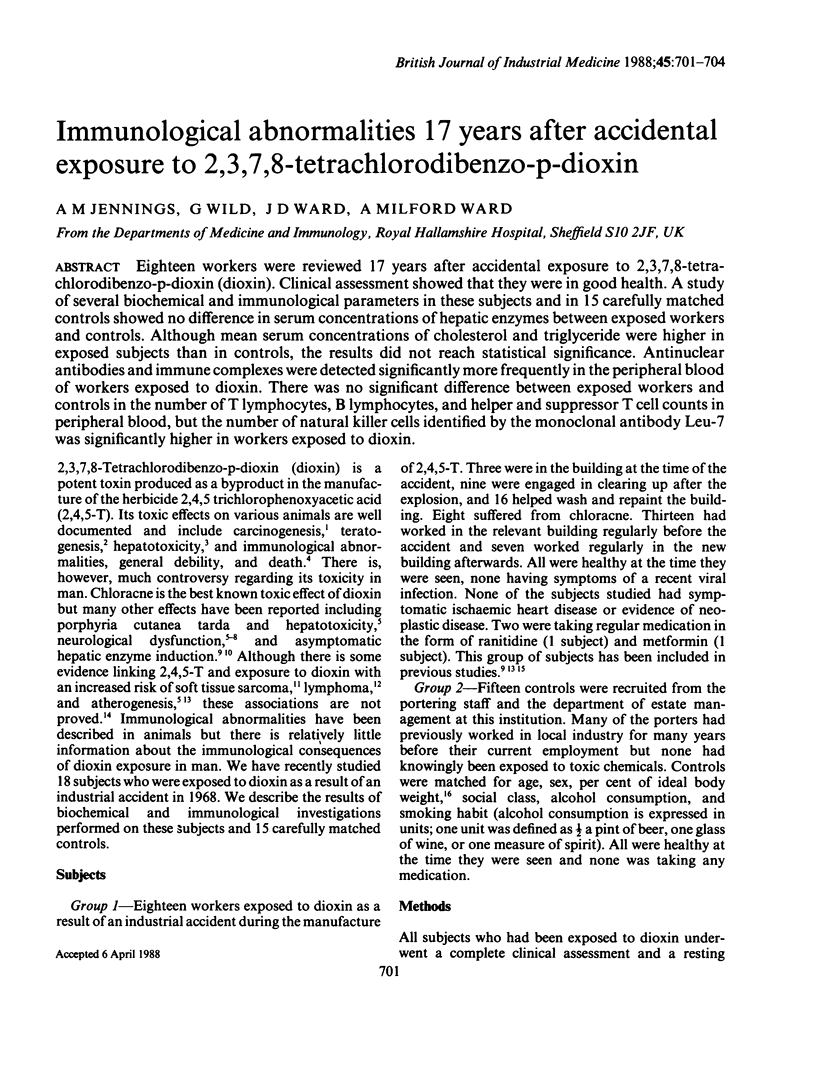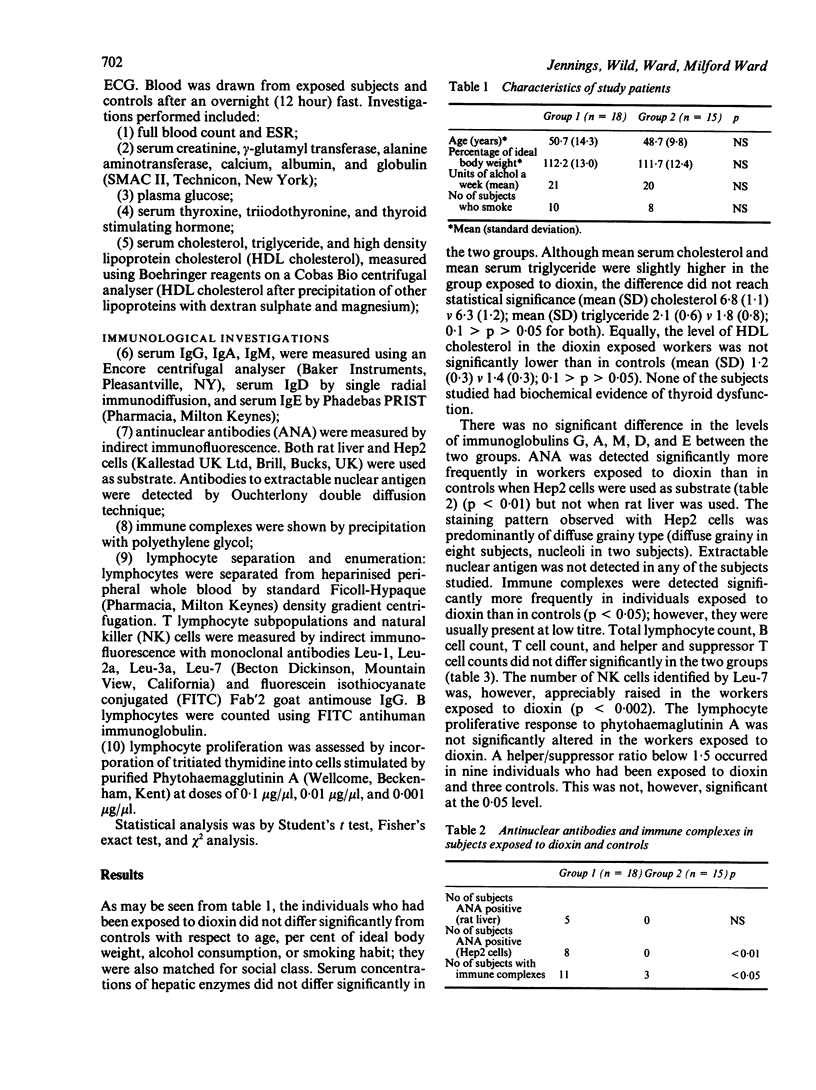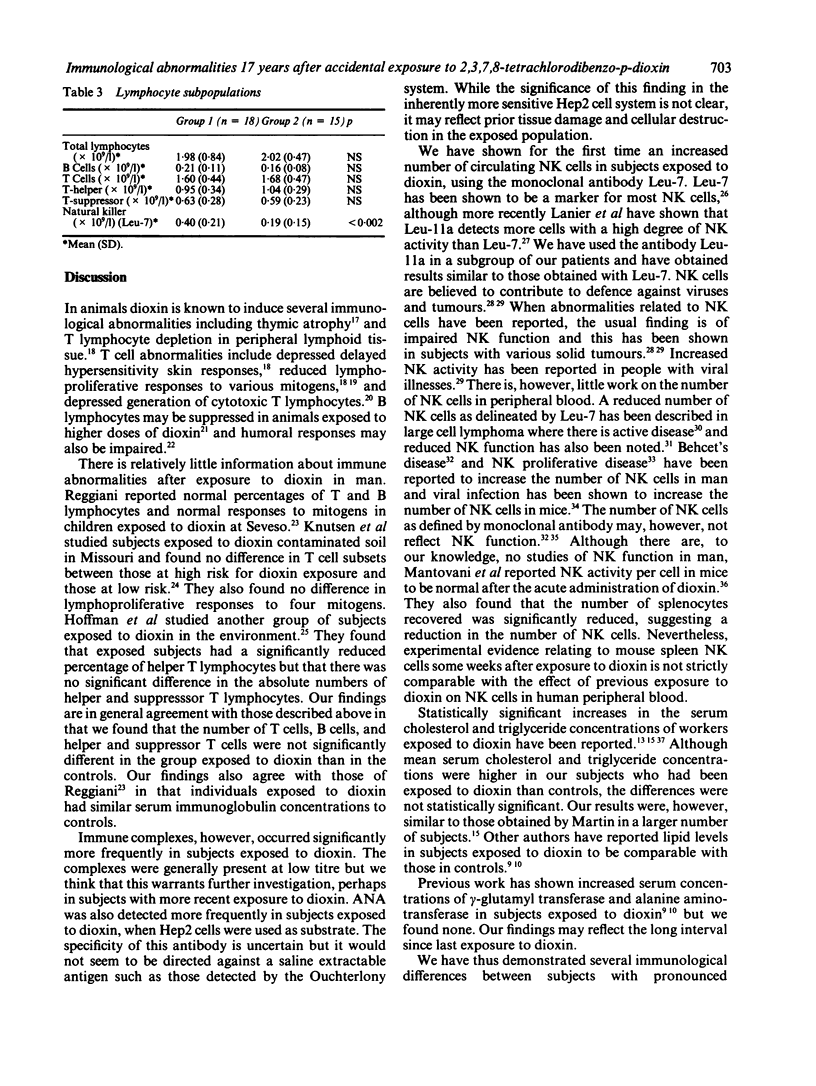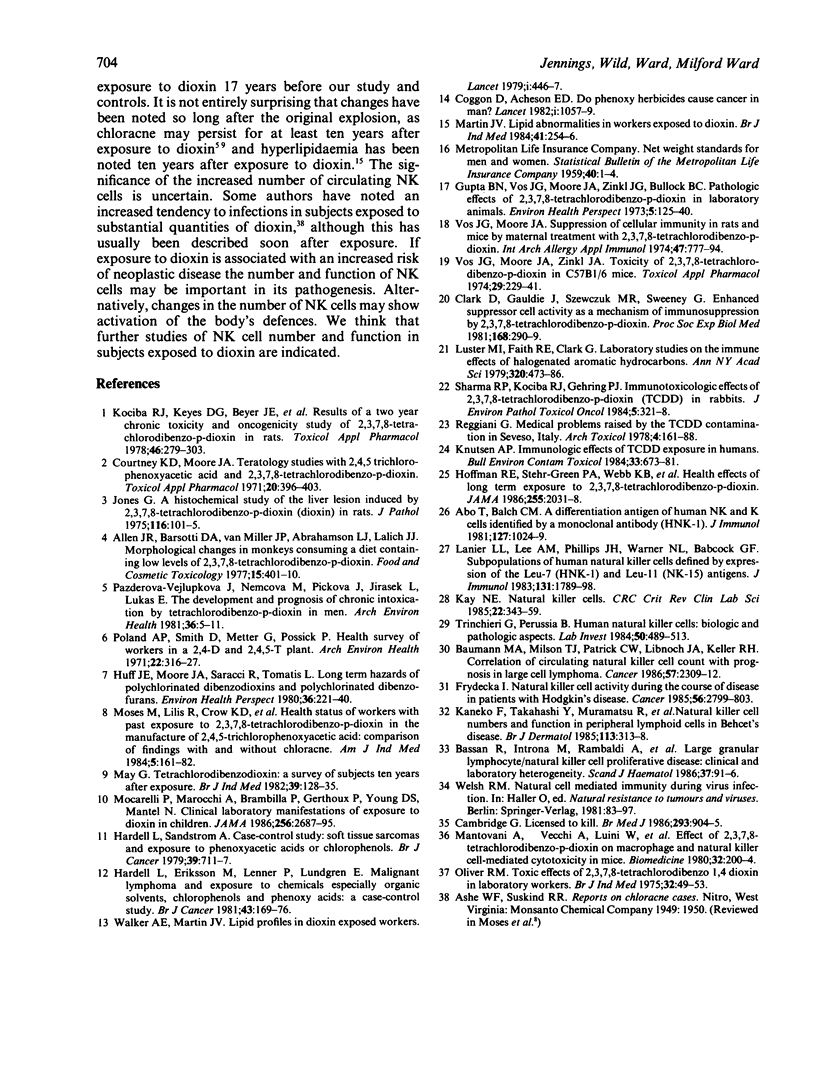Abstract
Eighteen workers were reviewed 17 years after accidental exposure to 2,3,7,8-tetrachlorodibenzo-p-dioxin (dioxin). Clinical assessment showed that they were in good health. A study of several biochemical and immunological parameters in these subjects and in 15 carefully matched controls showed no difference in serum concentrations of hepatic enzymes between exposed workers and controls. Although mean serum concentrations of cholesterol and triglyceride were higher in exposed subjects than in controls, the results did not reach statistical significance. Antinuclear antibodies and immune complexes were detected significantly more frequently in the peripheral blood of workers exposed to dioxin. There was no significant difference between exposed workers and controls in the number of T lymphocytes, B lymphocytes, and helper and suppressor T cell counts in peripheral blood, but the number of natural killer cells identified by the monoclonal antibody Leu-7 was significantly higher in workers exposed to dioxin.
Full text
PDF



Selected References
These references are in PubMed. This may not be the complete list of references from this article.
- Abo T., Balch C. M. A differentiation antigen of human NK and K cells identified by a monoclonal antibody (HNK-1). J Immunol. 1981 Sep;127(3):1024–1029. [PubMed] [Google Scholar]
- Allen J. R., Barsotti D. A., Van Miller J. P., Abrahamson L. J., Lalich J. J. Morphological changes in monkeys consuming a diet containing low levels of 2,3,7,8-tetrachlorodibenzo-p-dioxin. Food Cosmet Toxicol. 1977 Oct;15(5):401–410. doi: 10.1016/s0015-6264(77)80004-7. [DOI] [PubMed] [Google Scholar]
- Bassan R., Introna M., Rambaldi A., Viero P., Chisesi T., Mantovani A., Barbui T. Large granular lymphocyte/natural killer cell proliferative disease: clinical and laboratory heterogeneity. Scand J Haematol. 1986 Aug;37(2):91–96. doi: 10.1111/j.1600-0609.1986.tb01779.x. [DOI] [PubMed] [Google Scholar]
- Baumann M. A., Milson T. J., Patrick C. W., Libnoch J. A., Keller R. H. Correlation of circulating natural killer cell count with prognosis in large cell lymphoma. Cancer. 1986 Jun 15;57(12):2309–2312. doi: 10.1002/1097-0142(19860615)57:12<2309::aid-cncr2820571212>3.0.co;2-h. [DOI] [PubMed] [Google Scholar]
- Cambridge G. Licensed to kill. Br Med J (Clin Res Ed) 1986 Oct 11;293(6552):904–905. doi: 10.1136/bmj.293.6552.904. [DOI] [PMC free article] [PubMed] [Google Scholar]
- Clark D. A., Gauldie J., Szewczuk M. R., Sweeney G. Enhanced suppressor cell activity as a mechanism of immunosuppression by 2,3,7,8-tetrachlorodibenzo-p-dioxin. Proc Soc Exp Biol Med. 1981 Nov;168(2):290–299. doi: 10.3181/00379727-168-41275. [DOI] [PubMed] [Google Scholar]
- Coggon D., Acheson E. D. Do phenoxy herbicides cause cancer in man? Lancet. 1982 May 8;1(8280):1057–1059. doi: 10.1016/s0140-6736(82)92109-2. [DOI] [PubMed] [Google Scholar]
- Courtney K. D., Moore J. A. Teratology studies with 2,4,5-trichlorophenoxyacetic acid and 2,3,7,8-tetrachlorodibenzo-p-dioxin. Toxicol Appl Pharmacol. 1971 Nov;20(3):396–403. doi: 10.1016/0041-008x(71)90282-1. [DOI] [PubMed] [Google Scholar]
- Frydecka I. Natural killer cell activity during the course of disease in patients with Hodgkin's disease. Cancer. 1985 Dec 15;56(12):2799–2803. doi: 10.1002/1097-0142(19851215)56:12<2799::aid-cncr2820561215>3.0.co;2-w. [DOI] [PubMed] [Google Scholar]
- Gupta B. N., Vos J. G., Moore J. A., Zinkl J. G., Bullock B. C. Pathologic effects of 2,3,7,8-tetrachlorodibenzo-p-dioxin in laboratory animals. Environ Health Perspect. 1973 Sep;5:125–140. doi: 10.1289/ehp.7305125. [DOI] [PMC free article] [PubMed] [Google Scholar]
- Hardell L., Eriksson M., Lenner P., Lundgren E. Malignant lymphoma and exposure to chemicals, especially organic solvents, chlorophenols and phenoxy acids: a case-control study. Br J Cancer. 1981 Feb;43(2):169–176. doi: 10.1038/bjc.1981.25. [DOI] [PMC free article] [PubMed] [Google Scholar]
- Hoffman R. E., Stehr-Green P. A., Webb K. B., Evans R. G., Knutsen A. P., Schramm W. F., Staake J. L., Gibson B. B., Steinberg K. K. Health effects of long-term exposure to 2,3,7,8-tetrachlorodibenzo-p-dioxin. JAMA. 1986 Apr 18;255(15):2031–2038. [PubMed] [Google Scholar]
- Huff J. E., Moore J. A., Saracci R., Tomatis L. Long-term hazards of polychlorinated dibenzodioxins and polychlorinated dibenzofurans. Environ Health Perspect. 1980 Jun;36:221–240. doi: 10.1289/ehp.8036221. [DOI] [PMC free article] [PubMed] [Google Scholar]
- Jones G. A histochemical study of the liver lesion induced by 2,3,7,8-tetrachlorodibenzo-p-dioxin (dioxin) in rats. J Pathol. 1975 Jun;116(2):101–105. doi: 10.1002/path.1711160206. [DOI] [PubMed] [Google Scholar]
- Kaneko F., Takahashi Y., Muramatsu R., Adachi K., Miura Y., Nakane A., Minagawa T. Natural killer cell numbers and function in peripheral lymphoid cells in Behcet's disease. Br J Dermatol. 1985 Sep;113(3):313–318. doi: 10.1111/j.1365-2133.1985.tb02083.x. [DOI] [PubMed] [Google Scholar]
- Kay N. E. Natural killer cells. Crit Rev Clin Lab Sci. 1986;22(4):343–359. doi: 10.3109/10408368509165790. [DOI] [PubMed] [Google Scholar]
- Knutsen A. P. Immunologic effects of TCDD exposure in humans. Bull Environ Contam Toxicol. 1984 Dec;33(6):673–681. doi: 10.1007/BF01625599. [DOI] [PubMed] [Google Scholar]
- Kociba R. J., Keyes D. G., Beyer J. E., Carreon R. M., Wade C. E., Dittenber D. A., Kalnins R. P., Frauson L. E., Park C. N., Barnard S. D. Results of a two-year chronic toxicity and oncogenicity study of 2,3,7,8-tetrachlorodibenzo-p-dioxin in rats. Toxicol Appl Pharmacol. 1978 Nov;46(2):279–303. doi: 10.1016/0041-008x(78)90075-3. [DOI] [PubMed] [Google Scholar]
- Lanier L. L., Le A. M., Phillips J. H., Warner N. L., Babcock G. F. Subpopulations of human natural killer cells defined by expression of the Leu-7 (HNK-1) and Leu-11 (NK-15) antigens. J Immunol. 1983 Oct;131(4):1789–1796. [PubMed] [Google Scholar]
- Luster M. I., Faith R. E., Clark G. Laboratory studies on the immune effects of halogenated aromatics. Ann N Y Acad Sci. 1979 May 31;320:473–486. doi: 10.1111/j.1749-6632.1979.tb56628.x. [DOI] [PubMed] [Google Scholar]
- Mantovani A., Vecchi A., Luini W., Sironi M., Candiani G. P., Spreafico F., Garattini S. Effect of 2,3,7,8-tetrachlorodibenzo-p-dioxin on macrophage and natural killer cell-mediated cytotoxicity in mice. Biomedicine. 1980 Dec;32(4):200–204. [PubMed] [Google Scholar]
- Martin J. V. Lipid abnormalities in workers exposed to dioxin. Br J Ind Med. 1984 May;41(2):254–256. doi: 10.1136/oem.41.2.254. [DOI] [PMC free article] [PubMed] [Google Scholar]
- May G. Tetrachlorodibenzodioxin: a survey of subjects ten years after exposure. Br J Ind Med. 1982 May;39(2):128–135. doi: 10.1136/oem.39.2.128. [DOI] [PMC free article] [PubMed] [Google Scholar]
- Mocarelli P., Marocchi A., Brambilla P., Gerthoux P., Young D. S., Mantel N. Clinical laboratory manifestations of exposure to dioxin in children. A six-year study of the effects of an environmental disaster near Seveso, Italy. JAMA. 1986 Nov 21;256(19):2687–2695. [PubMed] [Google Scholar]
- Moses M., Lilis R., Crow K. D., Thornton J., Fischbein A., Anderson H. A., Selikoff I. J. Health status of workers with past exposure to 2,3,7,8-tetrachlorodibenzo-p-dioxin in the manufacture of 2,4,5-trichlorophenoxyacetic acid: comparison of findings with and without chloracne. Am J Ind Med. 1984;5(3):161–182. doi: 10.1002/ajim.4700050303. [DOI] [PubMed] [Google Scholar]
- Oliver R. M. Toxic effects of 2,3,7,8 tetrachlorodibenzo 1,4 dioxin in laboratory workers. Br J Ind Med. 1975 Feb;32(1):49–53. doi: 10.1136/oem.32.1.49. [DOI] [PMC free article] [PubMed] [Google Scholar]
- Pazderova-Vejlupková J., Lukás E., Nemcova M., Pícková J., Jirásek L. The development and prognosis of chronic intoxication by tetrachlordibenzo-p-dioxin in men. Arch Environ Health. 1981 Jan-Feb;36(1):5–11. doi: 10.1080/00039896.1981.10667598. [DOI] [PubMed] [Google Scholar]
- Poland A. P., Smith D., Metter G., Possick P. A health survey of workers in a 2,4-D and 2,4,5-T plan with special attention to chloracne, porphyria cutanea tarda, and psychologic parameters. Arch Environ Health. 1971 Mar;22(3):316–327. doi: 10.1080/00039896.1971.10665850. [DOI] [PubMed] [Google Scholar]
- Reggiani G. Medical problems raised by the TCDD contamination in Seveso, Italy. Arch Toxicol. 1978 Jun 16;40(3):161–188. doi: 10.1007/BF00364649. [DOI] [PubMed] [Google Scholar]
- Sharma R. P., Kociba R. J., Gehring P. J. Immunotoxicologic effects of 2,3,7,8-tetrachlorodibenzo-p-dioxin (TCDD) in rabbits. J Environ Pathol Toxicol Oncol. 1984 Jul;5(4-5):321–328. [PubMed] [Google Scholar]
- Trinchieri G., Perussia B. Human natural killer cells: biologic and pathologic aspects. Lab Invest. 1984 May;50(5):489–513. [PubMed] [Google Scholar]
- Vos J. G., Moore J. A. Suppression of cellular immunity in rats and mice by maternal treatment with 2,3,7,8-tetrachlorodibenzo-p-dioxin. Int Arch Allergy Appl Immunol. 1974;47(5):777–794. doi: 10.1159/000231268. [DOI] [PubMed] [Google Scholar]
- Vos J. G., Moore J. A., Zinkl J. G. Toxicity of 2,3,7,8-tetrachlorodibenzo-p-dioxin (TCDD) in C57B1/6 mice. Toxicol Appl Pharmacol. 1974 Aug;29(2):229–241. doi: 10.1016/0041-008x(74)90060-x. [DOI] [PubMed] [Google Scholar]


